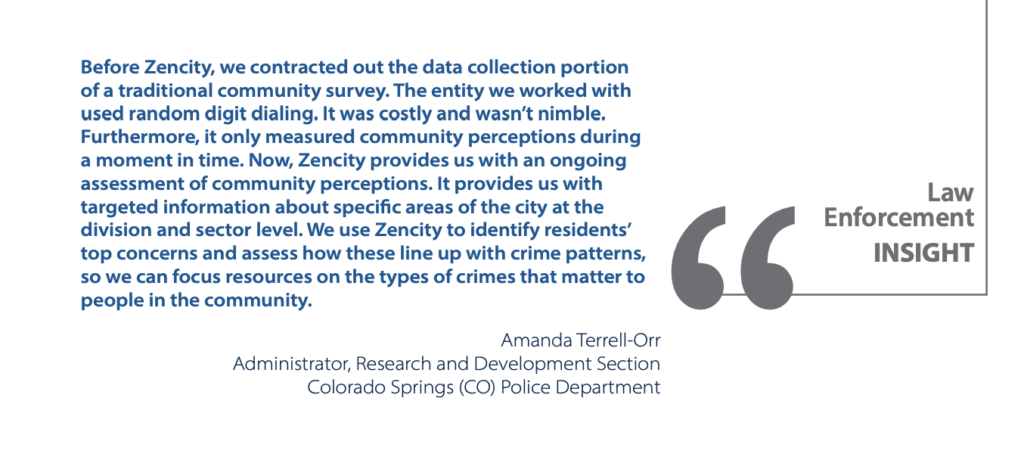Overview of the new NIJ Landscape Report on Measuring Community Sentiment and Perceptions of Safety and Law Enforcement Performance

Chief (ret.) David Rahinsky
Chief of Police (ret.)
Executive Summary
The US Department of Justice (DOJ) National Institute of Justice (NIJ) Criminal Justice Testing and Evaluation Consortium (CJTEC) this week published a landmark report titled “A Landscape Report on Measuring Community Sentiment and Perceptions of Safety and Law Enforcement Performance.”
This report outlines and examines three key methodologies for measuring community sentiment toward law enforcement, as the President’s Task Force recommended on 21st Century Policing. The report introduces various strategies for collecting this data, analyzes unique strengths and limitations, and the potential implications of this data for shaping policy and practice within law enforcement agencies. The report also provides a solutions landscape detailing the providers and solutions in all three areas today.
The report is a must-read for law enforcement executives and state and local government leaders that are key stakeholders in the public safety leadership of their jurisdictions.
Zencity is proud to be highlighted in this seminal report and the only solution provider in all three recommended categories. For agencies of any size seeking a “one-stop shop” that can provide one piece or the entire landscape of community perception capabilities required for success in the modern era, we are happy to discuss a strategy to bring these recommendations to reality.
Community Sentiment and Perception: An Overview
The report differentiates between five main categories of measures of community sentiment:
- perceptions of effectiveness,
- public satisfaction,
- procedural justice and legitimacy,
- fear of crime and safety, and
- social disorganization and emerging community problems/issues.
Each metric captures a distinct aspect of public perception of law enforcement.
The effectiveness of law enforcement in controlling and responding to crime, as perceived by the community, directly influences their overall satisfaction. The community’s recent interactions with the police also affect this satisfaction, whether resident-initiated (like a 911 call) or police-initiated (like a traffic stop).
The community’s perception of the police’s legitimacy and the procedural justice they uphold is another critical determinant of public sentiment. Higher perceived legitimacy can lead to improved compliance and cooperation with law enforcement. This legitimacy is intertwined with the community’s perception of the fairness demonstrated by the police.
The community’s fear of crime and concerns about personal safety significantly influence their overall sentiment towards law enforcement, as does their perception of emerging problems or unaddressed issues within their community. This can range from concerns about noise and graffiti to more serious problems like drug sales or gun violence.
The Value of Measuring Community Perception
The report underscores that measuring community perception is not a “nice to have” instead, it plays an essential role in ensuring the success and efficiency of law enforcement agencies.
Understanding the community’s sentiment allows for targeted improvements, fostering a stronger relationship between the police and the community. Law enforcement agencies can leverage this data to assess their performance, identify improvement areas, and track changes over time. Moreover, community sentiment metrics offer insight into the community’s perception of safety, enabling law enforcement agencies to better serve their communities by addressing safety concerns proactively.
Public trust in law enforcement significantly impacts its effectiveness. Law enforcement agencies that actively measure and respond to community sentiment often foster stronger community relationships. Trust leads to increased cooperation, reporting of crimes, and compliance with law enforcement directives. Therefore, understanding and considering community sentiment can contribute directly to public safety and crime reduction.

Methods to Measure Community Perception
The report discusses three primary methodologies for measuring the key facets of community perception: General Population Surveys, Post-contact Surveys, and Leveraging Data from Existing Sources.
General Population Surveys target a representative sample of the community to gather generalized perceptions about police performance and public safety. The strengths of this method include its ability to hear from all residents, its customizable nature, and its broad coverage of various measures. The report notes that, like any general population survey, responses may be influenced by external factors unrelated to the local agency (e.g., national events that swing public perception of law enforcement, as opposed to events in the community being surveyed.)
Post-contact Surveys are administered to individuals shortly after a police encounter. They provide direct insights into the perceptions of individuals who have had recent contact with the police. The report notes that this methodology is very effective in measuring the quality of interactions. However, as it is linked to community interactions with an agency, its responses may not accurately reflect the entire community’s overall perception of emerging problems or general safety.
Leveraging Data from Existing Sources involves using tools like sentiment analysis and natural language processing to aggregate data from various sources, such as social media and body-worn cameras (BWCs). While this approach can provide nuanced and time-sensitive insights, it may be affected by external national events and is not representative of the entire community.
Given these strengths and limitations, the report recommends a multi-faceted approach, combining two or more of the above methods to get a complete picture of community perception. It provides several case studies of agencies using a multi-faceted approach. (Zencity is the only provider cited in the report offering more than one method.)
Conclusion
The CJTEC insightful report provides a comprehensive overview of measuring community sentiment towards law enforcement. By understanding the different methodologies available and their relative strengths and limitations, law enforcement agencies can more effectively gauge public sentiment, helping shape more informed and inclusive policies and practices, ultimately aiming to improve the relationships between law enforcement agencies and their communities.
The invaluable data these new tools and methods provide enables law enforcement to not only address the recommendations of the President’s Task Force on 21st-Century Policing but also foster an environment of trust, transparency, and cooperation that advances the mission of every public safety agency.
Zencity is proud to be highlighted in this seminal report and the only solution provider in all three recommended categories. For agencies of any size seeking a “one-stop shop” that can provide one piece, all the way to the entire landscape of community perception capabilities required for today and beyond, we would be happy to help assess how best to get started.
%20copy-1.png?width=544&height=120&name=Logo_black%20(1)%20copy-1.png)



